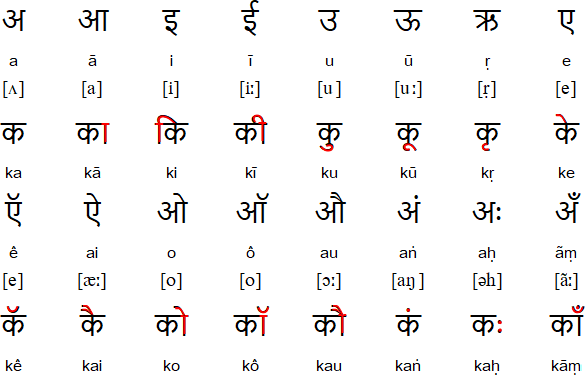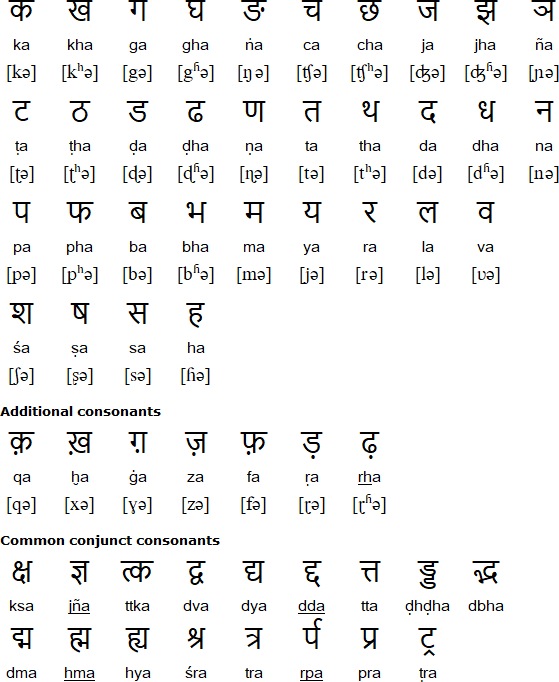The standard Hindi alphabet, as agreed by the Government of India, has 11 vowels and 35 consonants. However, the traditional Hindi alphabet is considered to be made of 13 vowels and 33 consonants. The letters अं [am] and अः [ah] are counted as vowels in traditional Hindi and as consonants in standard Hindi. It also includes two letters ड़ [rr] and ढ़ [rh] which are counted as consonants in the standard official Hindi alphabet.
In popular and traditional teachings, three extra consonants are used. They are called conjuncts and are a combination of two consonants. This happens when successive consonants with no vowel between them physically join together, for example: क्ष [ksh]is a combination of क and ष, [k] and [sh]
त्र [tr] is a combination of त and र, [t] and [r]
ज्ञ [jna] or [gya] is a combination of ज and ञ, [j] and [n]
Special characters
In some words, written vowels change their form in order to join up with consonants.
- With ‘aa’: ा - का [kaa] is a combination of क + आ (k + aa). The characterा is added to the right.
- With ‘i’: ि – कि [ki] is a combination of क + इ (k + i). The character ि is added to the left and above.
- With ‘ee’:ी – की [kee] is a combination of क+ ई (k + ee). The character ी is added to the right and above.
- With ‘u’: ु – कु [ku] is a combination of क + उ (k + u). The character ु is added below.
- With ‘oo’: ू - कू [koo] is a combination of क + ऊ (k + oo). The character ू is added below.
- With ‘ae’: े – के [kae] is a combination of क + ए (k + ae). The character े is added above.
- With ‘aae’: ै – कै [kaae] is a combination of क + ऐ (k + aae). The character ै is added above.
- With ‘o’: ो – को [ko] is a combination of क + ओ (k + o). The character ो is added to the right and above.
- With ‘au’: ौ – कौ [kau] is a combination of क+ औ (k + au). The character ौ is added to the right and above.
- With ‘ri’: ृ – कृ [kri] is a combination of क +ऋ (k + ri). The character ृ is added below.
For example, BBC is a combination of three vowels and three consonants in Hindi:
ब [b]+ ई [ee] - ब [b]+ ई [ee] - स [c]+ ई [ee]
So, instead of writing it बईबईसई, BBC would be written as बीबीसी, using the character ी.
Similarly, the word radio would be a combination of three sets of vowels and consonants, for example:
र [r] + ए [ae] + ड[d] + इ[i] + ओ [o]
So, instead of writing it रएडइओ, it would be written as रेडियोusing the characters े, ि and ोे.
The horizontal line
The horizontal line on top of letters plays an important role in Hindi. Words formed by different letters are joined by this line, as in
You are trying to view Flash content, but you have no Flash plugin installed.
कलम, [kalam], pen, which is made of three consonant letters,क[k],ल [l] andम [m]. All letters have this line except for two consonants:ध [dh] and भ [bh].
The right stroke
24 out of the 36 consonants contain a vertical right stroke, for example ख [kh], घ [gh], ण [n]. Its purpose is to mark a full stop. But nowadays, a normal full stop is frequently used to end a sentence.





Post a Comment